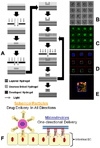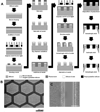Microfabricated implants for applications in therapeutic delivery, tissue engineering, and biosensing
- PMID: 18941687
- PMCID: PMC2970504
- DOI: 10.1039/b806446f
Microfabricated implants for applications in therapeutic delivery, tissue engineering, and biosensing
Abstract
By adapting microfabrication techniques originally developed in the microelectronics industry novel devices for drug delivery, tissue engineering and biosensing have been engineered for in vivo use. Implant microfabrication uses a broad range of techniques including photolithography, and micromachining to create devices with features ranging from 0.1 to hundreds of microns with high aspect ratios and precise features. Microfabrication offers device feature scale that is relevant to the tissues and cells to which they are applied, as well as offering ease of en masse fabrication, small device size, and facile incorporation of integrated circuit technology. Utilizing these methods, drug delivery applications have been developed for in vivo use through many delivery routes including intravenous, oral, and transdermal. Additionally, novel microfabricated tissue engineering approaches propose therapies for the cardiovascular, orthopedic, and ocular systems, among others. Biosensing devices have been designed to detect a variety of analytes and conditions in vivo through both enzymatic-electrochemical reactions and sensor displacement through mechanical loading. Overall, the impact of microfabricated devices has had an impact over a broad range of therapies and tissues. This review addresses many of these devices and highlights their fabrication as well as discusses materials relevant to microfabrication techniques.
Figures






References
-
- Madou M. Fundamentals of Microfabrication: The Science of Miniaturization. ed. 2nd. New York, NY: CRC Press; 2002. p. 723.
-
- Lim JY, Donahue HJ. Tissue Engineering. 2007;13:1879. - PubMed
-
- Jung DR, Kapur R, Adams T, Giuliano KA, Mrksich M, Craighead HG, Taylor DL. Critical Reviews in Biotechnology. 2001;21:111. - PubMed
Publication types
MeSH terms
Grants and funding
LinkOut - more resources
Full Text Sources
Other Literature Sources
Research Materials

